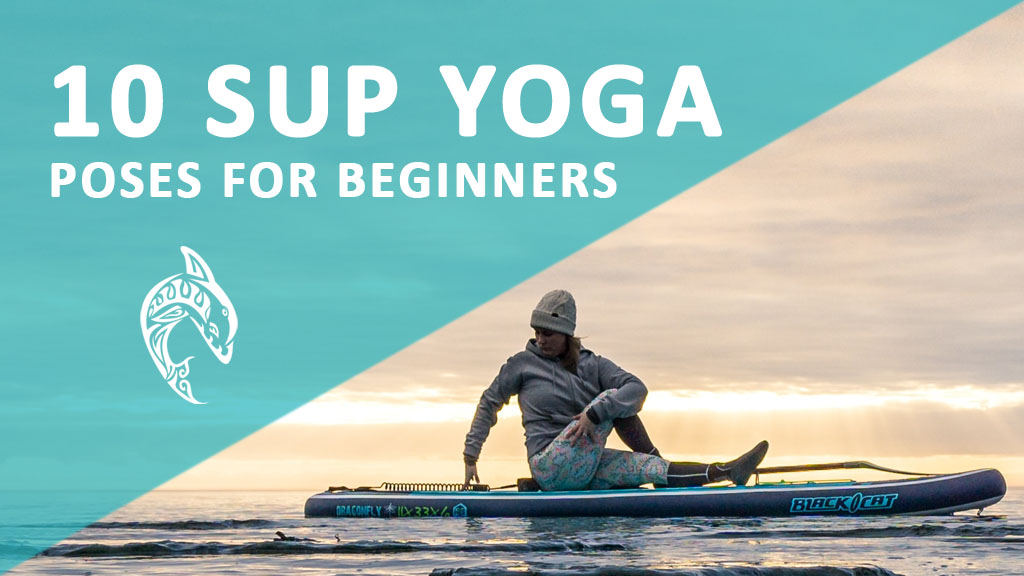Do you want to improve your balance, destress, and get in touch with nature? Keep reading and discover the world of Yoga on Paddle Boards.
My name’s Eddie, and I’m passionate about the wellness of the body and mind. I was the creative director for Pace Fitness and seasoned paddle board instructor from Southern California.
In this article I’m going to cover yoga poses that you can do right away to loosen your joints, gain balance, destress, or get back in shape.
Before we get started here are some key tips.
Most stable position: The greatest balance is found at the center of the board located around the paddle board’s handle. Be mindful of this location, and position your body over it at all times.
Pace: Don’t rush yourself. Move slowly when transitioning from different positions.
Focus: Your equilibrium is improved when you focus on a single point. Looking around too much or too quickly can distract you and lose balance.
Time: It’s recommended to hold for 30-60 Sec for each pose.
Poses we’ll be going over
The key thing to keep in mind while doing these poses is to maintain a rhythmic breathing.
If you are holding your breath to do these pose it forces your body to tighten. This is the opposite of what we want to do.
So remind yourself over and over to breath in and breath out. Try do do each pose for 30 seconds before moving onto the next.
Let’s begin!
EASY SEAT
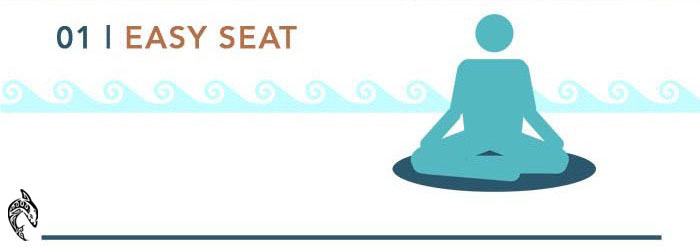
This is a pose we all used to practice as children but lose the ability over time due to poor posture and sitting in chairs all day.
This is a great pose if you have very tight hips.
Benefits
- Strengthens the back
- Stretches the knees and ankles
- Opens the hips, groin, and abductors (outer thighs muscles)
- Straightening your spine reduces stress and anxiety.
Caution
- Avoid this pose if you have knee injuries
- Never force the pose
- Don’t over extend
Step-by-Step Instruction
- Begin by sitting right behind the paddle board handle.
- Bring you ankles under your buttocks.
- Gently lower down until you are comfortably resting on yoru .
- Broaden your knees.
- Slide your ankles underneath your knees.
- Straighten your back.
- Place your hands on your knees with palms facing up.
- Touch your thumb and index finger together (Gyan Mudra)
HERO

This is a great posture pose and increases flexibility in your knees and hips while improving your arches in the feet.
Benefits
- Stretches the hips, thighs, knees, ankles and feet.
- Improves foot arches and blood circulation in legs.
- Loosens your shoulder and chest muscles.
- Improves posture.
- Straightening your spine reduces stress and anxiety.
Caution
- Avoid this pose if you feel knee or ankle pains.
- Sit on a box if you cannot go all the way down.
- Keep your feet under your buttocks and not spread out.
Step-by-Step Instruction
- Start on your knees shoulder width apart on both sides of the paddle board handle.
- Gently lower down until you are comfortably resting on your legs.
- Bring your arms behind you.
- Lock your fingers behind your lower back.
- Pull your shoulders back.
- Expand your chest.
SEATED TWIST
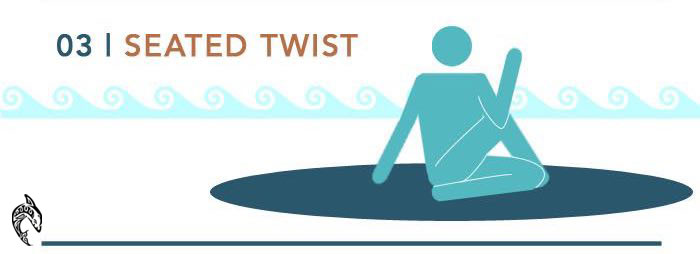
This pose is good for lengthening the spine and increasing range of motion.
Benefits
- Opens the rib cage and chest.
- Stretches the shoulders, hips, back, and neck
- Reduces stress on the spine.
Caution
Avoid this pose if you have.…
- Spinal injuries
- Back pain
- Pregnancy
Step-by-Step Instruction
- Start in the seated position in the center of the board.
- Curl your right leg in until your heel is near your crotch.
- Bring you left knee up and set your left foot down next to the right side of your right knee.
- Rotate your chest to your left side.
- Rest your left hand down about 12 inches behind your buttocks.
- Place your elbow against your the left side of you left knee.
- Rotate your head to look behind you.
- Here you can twist your torso until you feel a comfortable stretch.
- Hold for 30-60 seconds.
- Slowly return to the seated position and repeat on the other side.
THREAD THE NEEDLE

This pose provides relief from stiffness and pain in your back, shoulders, and neck.
Benefits
- Stretches the shoulders, chest, arms, upper back, and neck.
- Releases tension in the upper back and shoulder blades.
- Reduces stress on the spine.
Caution
Avoid this pose if you have chronic injuries to your.…
- Knees
- Shoulders
- Neck
Step-by-Step Instruction
- Start on your hands and knees on the board.
- Put your wrists directly under your shoulder and your knees directly under your hips in a table pose.
- Bring your right shoulder down to the board.
- Slight bend your left elbow.
- Extend your right arm behind your left hand, palms up.
- Turn your head to the left side.
- Hold for 30-60 seconds.
- Slowly return to the table position and repeat on the other side.
LOW LUNGE
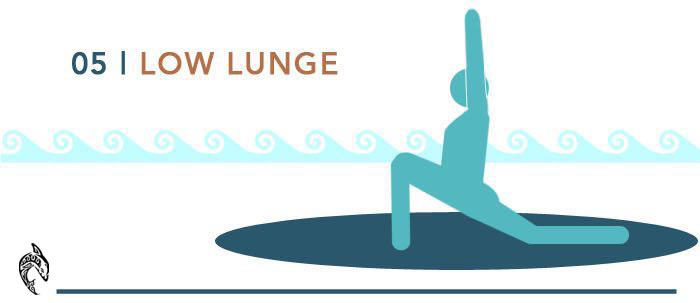
Low lunges are excellent for your glutes and hamstrings.
Benefits
- Stretches the quadriceps, hamstrings, groin and hips.
- Perfect for people who run or cycle.
- Increases range of motion from sitting all day.
Caution
- Touch your knee if you can’t make it all the way down.
- Make sure your front foot is in the middle of the board when starting.
Step-by-Step Instruction
- Begin with table pose like Thread the Needle.
- Bring your left foot forward towards the left side of your left hand.
- Straighten your right leg behind you.
- Keep your arms straight up and straighten your back.
- Hold for 30-60 seconds.
- Slowly lower down and repeat on the other side.
WARRIOR I
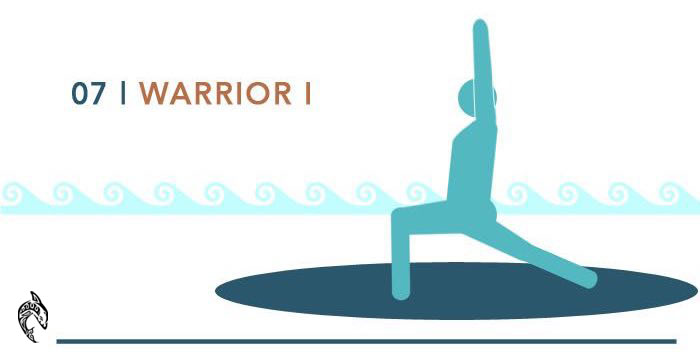
This is a strong standing pose that develops stamina, balance, and coordination.
Benefits
- Tones the abdomen, ankles, and arches of the feet.
- Strengthen the thighs, glutes, and back.
- Stretches the chest and opens up the lungs.
- Improves overall balance.
Caution
Avoid this pose if you have.…
- High blood pressure
- Heart problems
Step-by-Step Instruction
- Start on your hands and knees on the board.
- Put your wrists directly under your shoulder and your knees directly under your hips in a table pose.
- Bring your left foot forward towards the center of your upper chest.
- Straighten your right leg behind you.
- Raise your body up until your left leg is bent in front of you.
- Slowly bring your arms up over your head and touch your palms together.
- Hold for 30-60 seconds.
- Repeat the process on the other side.
WARRIOR II
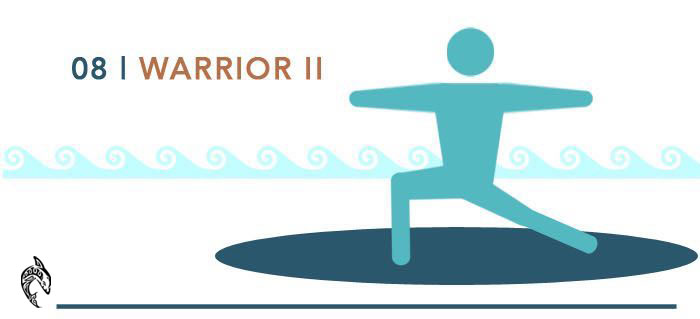
This is a strong standing variation of Warrior I.
Benefits
- Tones the abdomen, ankles, and arches of the feet.
- Strengthen the thighs, glutes, and back.
- Stretches the chest and opens up the lungs.
- Improves overall balance.
Caution
Avoid this pose if you have.…
- High blood pressure
- Heart problems
Step-by-Step Instruction
- Start with the Warrior I position.
- Instead of bringing your arms over your head, you are going to extend them out fully.
- Rotate your torso, as your point your arms to the front and back of the board.
- Hold for 30-60 seconds.
- Repeat the process on the other side.
CAT-COW
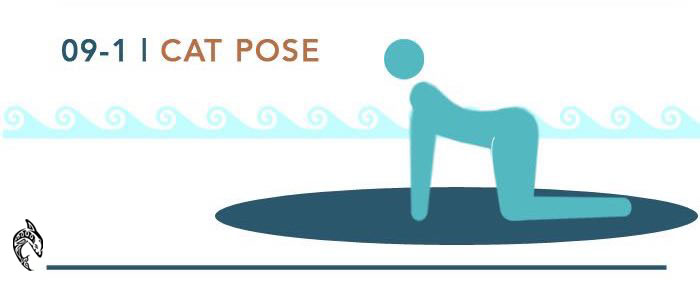
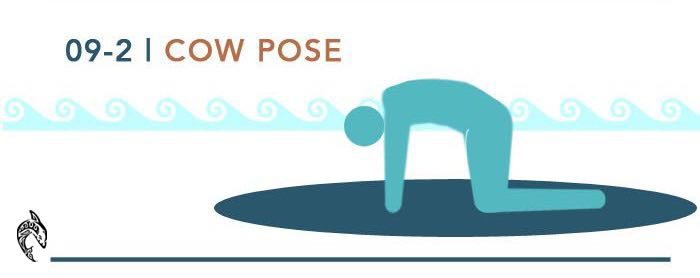
This is message to the spine and belly while relieving a lot of tension and stress. There should be no pain and very little discomfort while doing this exercise.
Benefits
- Tones the abdomen, ankles, and arches of the feet.
- Strengthen the thighs, glutes, and back.
- Stretches the chest and opens up the lungs.
Caution
Avoid this pose if you.…
- Pregnant
- Have back injuries
Step-by-Step Instruction
- Start on your hands and knees on the board.
- Put your wrists directly under your shoulder and your knees directly under your hips in a table pose.
- Inhale as you drop your stomach towards the mat in the cow pose.
- Lift your chin and chest, and gaze up toward the ceiling.
- Hold for 10-20 seconds
- As you exhale, draw your stomach to your spine and round your back toward the ceiling in the cat pose.
- Bring your forehead towards the direction of the floor.
- Hold for 10-20 seconds.
- Repeat the process 3 times in each pose.
CHILD
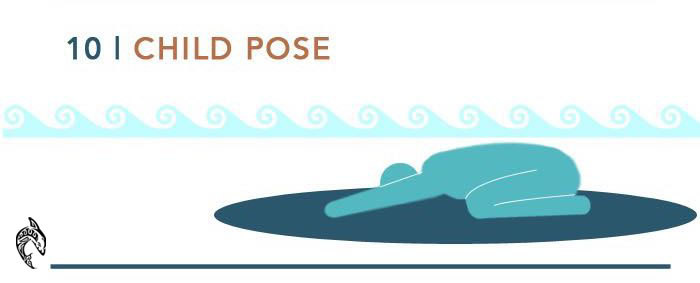
This is my favorite pose because of how well it stretches my shoulders which I use a lot in paddle boarding.
Benefits
- Relaxing stretch for your arms and back.
- Very effective at relieving tension in your shoulders.
Caution
Avoid this pose if you have.…
- Shoulder injuries
Step-by-Step Instruction
- Start kneeling with your knees on both sides of the paddle board handle.
- Cross your feet together but not your ankles.
- Sit back on your heels as your spread your knees.
- Lift your chin and chest, and gaze up toward the ceiling.
- Bring your arms as far forward as possible.
- Press your chest gently down onto the board, feeling a deep stretch in your shoulder muscles.
- Rotate your palms upwards to get an additional stretch.
- Hold for 30-60 seconds.
CONCLUSION
That’s my list of paddle boarding yoga poses that will really help you in your lower back, upper back, and shoulders which are often overused in paddle boarding.
Let’s go over what we learned!
✓Practice paddle board yoga to loosen your joints, gain balance, destress, or get back in shape
✓Focus on your breathing and meditation in the Easy Seat.
✓Don’t forget to lock your fingers behind you as you stretch your shoulders and chest in the Hero pose.
✓The Seated Twist is great for increasing your range of motion in your spine.
✓Threading the Needle is a little more difficult to set up but it is worth it to get to those hard to reach tight places in your shoulders, abdomen, and back.
✓Tone your legs and glutes by dropping as low as possible in the Low Lunge.
✓Practice the Warrior I and II to improve your stabilizer muscles for better balance.
✓Take a moment to relax and let your stress go away with the Cat-Cow pose.
✓Finish off with my favorite and most effective Child pose to relieve the tension in your shoulders.

